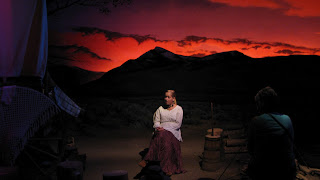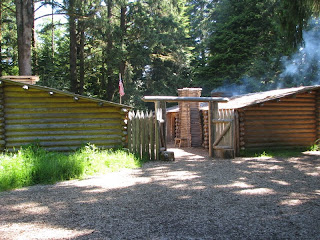July 30-August 5, 2012 – Fort Bridger, WY and Garden City, UT
After the military fort was abandoned most of the buildings
were sold at a public auction and moved off the grounds. A few original structures still exist like
this ice house.
The commanding officers house was very nice.
Many of the rooms in the house were set up as they were when
a commanding officer lived here. We
found these two chairs made from horns and antlers very interesting.
Restoration work on the fort is ongoing and archaeological
research has been done so that the story and buildings of Fort Bridger can be
preserved and protected. After we
finished touring the fort we had a picnic lunch in the adjacent park and
continued to Garden City, UT.
We are staying at Apple Garden Park, a very nice park in the
Camperworld membership park system.
We are just north of Garden City, UT and across the street
from Bear Lake. Bear Lake lies on the
border of Utah and Idaho and is 20 miles long and 8 miles wide. The beautiful turquoise blue color is created
when the sunlight reflects off suspended particles of calcium carbonate in the
water.
We drove Logan Canyon which follows the Logan River between
Garden City and Logan where we stopped at Tony Grove Lake. Tony Grove is a beautiful mountain lake and during
the 1880’s and 1890’s, wealthy families from Logan would spend six weeks in a
lush grove of trees that once existed nearby.
Early Logan residents dubbed the area Tony Grove because of its
popularity with the “tonies” or high-toned, uptown set. We spent part of the morning kayaking around
this gorgeous little lake.
Farther up Logan Canyon, we did some 4-wheeling on a side
road to Old Ephraim’s Grave. The plaque
on the monument reads
At the base of the monument was inscribed
“Old Ephraim, Old Ephraim, your deeds were so wrong, yet we
build you this marker and sing you this song.
To the king of the forest so mighty and tall, we salute you old Ephraim
the king of them all. Dephi J. Bott”
One description we read said that he was the last grizzly
bear in Utah, but this monument did not say anything about that so we aren’t
sure if it is true or not. We enjoyed this scenic drive through Logan Canyon.
One night we went to the Pickleville Playhouse where we had a great BBQ dinner outside at Bandito’s Wild West Grill before going in to see The Hanging of el Bandito Reimagined. The cast did an excellent job with the melodrama but we were a little disappointed because we were expecting an old fashioned melodrama and this was not. It had the melodrama theme with the damsel in distress, a good guy and a bad guy, but there was a lot of rap and hip hop music and dancing with the volume way too loud for our taste.
The next day we drove north into Idaho and visited
Minnetonka Cave in the Cache National Forest.
Edward Arnell discovered the limestone cave in 1906 or 1907 while
hunting. It was originally called
Porcupine Cave because a live porcupine and porcupine bones were found in the
cave. The 90 minute tour goes to the cave’s 9
rooms. We walked about ½ mile and
climbed up and down 444 stairs during the tour, of course we had to climb up
and down the 444 stairs on the way back out of the cave. Although this cave was small and not as
spectacular as other caves we have toured we did enjoy it.
After
touring Minnetonka Cave we drove to Montpelier, ID where we had a great lunch
at Lott’s Restaurant. After lunch we
went to the National Oregon/California Trail Center which is built right on top
of the Oregon Trail. The display outside
the Center depicts emigrants descending the “Big Hill” which is about 4 miles
south of Montpelier. The Big Hill is
said to be the greatest impediment the emigrants faced on their way west. The descent is so steep that the wagons had
to be let down by ropes tied to trees - similar to the hill we saw in Oregon on
the Barlow Road portion of the Oregon Trail last year.
Inside
the center it is the year 1852 and we are starting our 2,000 mile 5-month
journey from Independence, Missouri to the Oregon Territory on the Oregon
Trail. Our Wagon Master helped us
purchase everything we would need for the journey west – it will cost between
$1,200 and $1,500, a hefty sum in 1852!
Everyone over the age of 12 had to carry a gun, even the women so we
bought two 54 caliber Hawkins rifles at $20 apiece. We had to purchase a wagon and oxen - we were
told oxen were better than horses or mules as they did not have to stop during
the day to graze, they were cheaper to buy and, most important, the Indians
would not steal them.
After
getting the weapons, wagon and oxen we headed for the store to purchase our one
ton of supplies necessary for the trip. We
bought bacon, beans, coffee, flour, rice, sugar, salt, lard, and hardtack to
name a few or the many food items we need.
We also need clothing, bedding, tools, candles, matches, pots, pans,
tubs, buckets, rope, axe, a milk cow and chickens among other supplies. Our Wagon Master is showing Nancy which
grinder to purchase for grinding grain into flour.
After purchasing our supplies we boarded our covered wagon and headed out. The wagon was set up to bounce and jolt just like it was being pulled by oxen over a rough trail. Along the way we heard stories from emigrants about their hardships along the trail. After our harrowing descent down the Big Hill, we stopped at Clover Creek Encampment (an actual Oregon Trail camp which the Center is built over). Mrs. White welcomed us to camp and told us many stories about her journey on the Oregon Trail so far.
She then took us to her camp where she showed us the quilts and rugs that she makes. The rugs are called “wagon wheel rugs” because the material is tied to a wagon wheel rim and then woven together to make the rug – she said she uses old shirts and dresses. She invited Nancy to sit in a large rocker which she and her husband carried in their wagon all the way from Missouri. The chair kept falling out of the wagon and after picking it up numerous times, Mr. White said they needed to discard it. This chair has been in Mrs. White’s family for many generations so she said if the chair does not go then she wouldn’t go. Well to make a long story short, Mr. White continued on down the trail and left her. Another man at the end of the wagon train put the chair in his wagon and when they caught up with Mr. White later, he was certainly surprised to see her and the chair.
What a great way to learn the history of the Oregon Trail –
by experiencing it! The center also had
a railroad museum in the basement and a quilt display and traveling exhibit on
Sasquatch on the upper level. We really
enjoyed the National Oregon/California Trail Center and encourage anyone
visiting this area to go see it. On the
way back to Garden City we drove around the other side of Bear Lake.
We were amazed at how clear and detailed the fossils are that were displayed in the visitor center. There are fossils of all kinds of plants, flowers, fish, birds, turtles, insects, reptiles, and mammals. This palm frond was beautiful – they have found palm fronds up to 9 feet tall.
This large dragonfly was very detailed – they have found fossils of dragonflies with wing spans up to 4 inches.
They had a number of turtle fossils on display – the brochure said they have found turtle fossils up to 6 feet long.
While we were at the visitor center a ranger was using a small air gun under a microscope to sand blast a fossil. He said they do not use sand they use a grit that is harder than the stone but softer than the fossil so as not to damage the fossil. A camera was mounted looking into the microscope so we could watch a close-up video of him as he worked. It was interesting to watch and see how tedious the work really is. This was a very interesting national monument and we enjoyed our visit.
We enjoyed our visit to the Bear Lake area – especially the
raspberry shakes they sell in Garden City.
This area is known for its raspberries and was celebrating Raspberry
Days this weekend. We went to the arts
and crafts fair and found some really good raspberry salsa and some great kettle
corn.





















.JPG)
Comments
Post a Comment